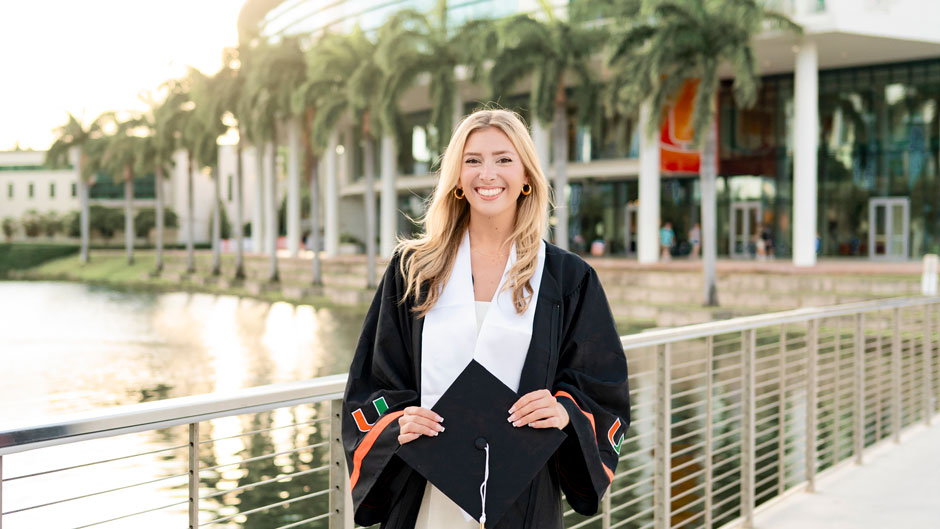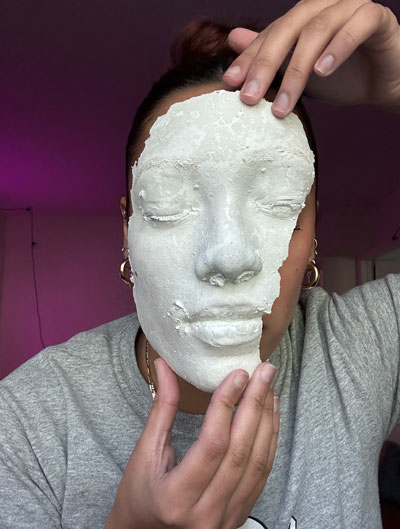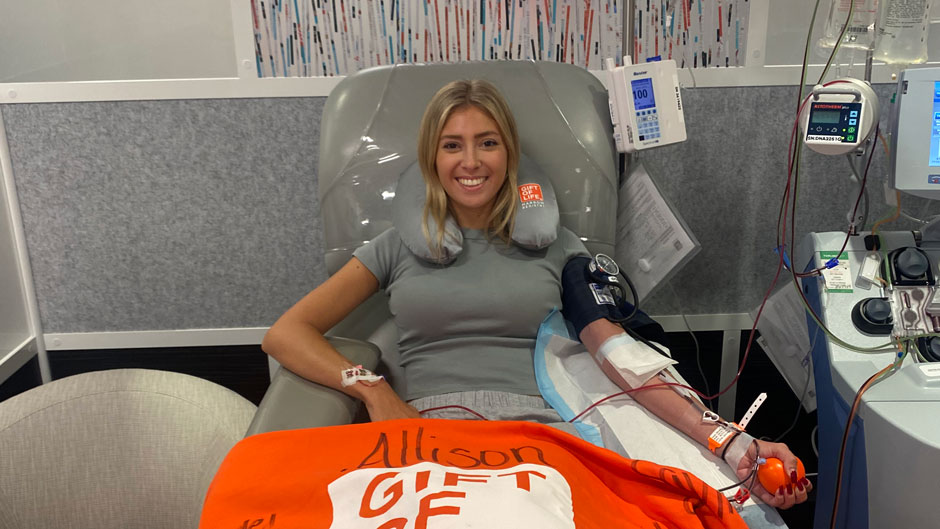Allison Micale signed up for a bone marrow and blood stem cell donor registry in 2021 when a registry organization visited her sorority chapter at the University of Miami.
Then, in February of her senior year, just months before graduation, Micale received life-changing news: she was a match for a 67-year-old woman battling acute myelogenous leukemia who desperately needed a blood stem cell transplant. By replacing a patient’s sick stem cells with a donor’s healthy ones, transplants of stem cells found in bone marrow and circulating blood can cure or treat blood cancers like leukemia, as well as other diseases.
Despite the less-than-ideal timing, Micale didn’t hesitate. Her sister’s best friend had been diagnosed with leukemia at the age of 16, and a transplant had saved her life.
“I always had that in my mind that if someone needed me, I wanted to help,” said Micale, a psychology major in the College of Arts and Sciences who graduated in May. “There was never a doubt in my mind that I wanted to donate.”
When she received the call, Micale was enrolled in Death and Dying, a course in the Department of Religious Studies that explores ideas and practices related to death from the ancient Mediterranean to the modern world. One of the guest speakers who visited the class was Thomas Champney, a professor in the Leonard M. Miller School of Medicine who spoke to the students about body donation. Micale saw the connection between body donation and her donation plans and decided to document her experience for the class.
“I took this project as an example of what death is like in modern times and how we do everything to escape it,” Micale said. “Where once an illness might claim a life swiftly, we now see lives extended in a delicate balance of treatment and hope. Death has become a more drawn-out affair, with each medical breakthrough snatching more time and each donation acting as resistance against dying.”

With photos and journal entries, Micale chronicled the donation process. The method for collecting blood stem cells depends on the needs of the patient, and in Micale’s case, she was asked to donate stem cells from her circulating blood, rather than from her bone marrow.
The process began with five days of filgrastim injections to increase Micale’s stem cell production. Then she traveled to the Gift of Life stem cell collection center in Boca Raton, Florida, where for five hours she was hooked up to an apheresis machine that took blood from one of her arms, extracted the stem cells, and returned the rest of the blood to her other arm.
During the process, Micale had the opportunity to write an anonymous letter to the recipient of her donation, which she shared with the class as part of her final project.
“This small act of sharing part of myself is a gift that I am immensely grateful to have been able to give,” Micale wrote. “If in these cells there is hope, if in them there is relief, then sharing them with you is one of the most meaningful contributions I could hope to make in another person’s life.”
Robyn Walsh, an associate professor in the Department of Religious Studies who teaches the Death and Dying course, was deeply impressed by Micale’s final project.
“She did this because she’s a wonderful, generous person, but she could see how what we were learning in the class related to this personal decision she was making and the greater implications of what she was doing,” Walsh said.

As evidenced by Micale’s final project, the Death and Dying course goes beyond readings and discussions. When students learn about the Civil War era practice of making death and life masks, for example, they make similar masks in class. For their final assignment, students have the option of completing a project that shows how they have taken the course material and applied it outside the classroom.
Other final projects have included true crime podcasts and interviews with police officers about their experiences with death. During the spring semester, a student studying architecture did his final project on a cemetery he was helping to design in Virginia Key.
“It’s always amazing for me because I see what they are making of our course materials,” Walsh said. “I hope as time goes on and they live these long and fruitful lives, they think back to the class when they have to deal with these issues and feel a little bit more equipped to face it.”
For Micale, who is about to embark on a career in human resources in New York City, the Death and Dying course changed her perspective on the end of life. “It was a fascinating and deeply thought-provoking class,” she said. “In a way, it has made me appreciate the preciousness of life and death even more, understanding that every moment we have is a gift.”

